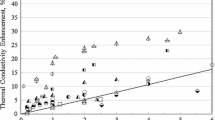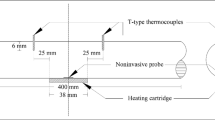Abstract
This work focuses on the nonlinear electrochemical (EC) activity of fluids and its impact on the accuracy of their thermophysical property measurements using the transient or periodically modulated hot wire method (THW or 3ωHW). This underestimated source of errors becomes crucial for nanofluids, where the thermal conductivity enhancement coefficient (k/k0 − 1) is small, requiring high-resolution measurements (below 1%). Theoretical predictions combining thermal and EC nonlinearities are confronted to experimental results obtained with two variants of 3ω cells. Water-based nanofluids (TiO2 and Al2O3) and water solutions of acetic acid, sodium hydroxide and sodium chloride were tested. The two classes of samples show different 3ω amplitude and phase behaviors, which is attributed to additional electrokinetic effects in nanofluids. For all studied samples an anti-correlation between the magnitude of the harmonics and the dc electrical resistivity of the samples was observed. A simple estimation method of 3ωHW errors is proposed consisting in measuring the 2nd harmonic in addition to the 3rd one. The combination of 2nd and 3rd harmonics allowed determining the nonlinearity coefficient which quantitatively characterizes the EC activity of samples. Eventually, the radical solution to avoid the discussed sources of errors is to use an electrically insulated hot wire sensor.






Similar content being viewed by others
Abbreviations
- 3ωHW:
-
3omega hot wire
- Bk:
-
Background signal
- DI:
-
Deionized (water)
- EC:
-
Electrochemical
- EK:
-
Electrokinetic
- HW:
-
Hot wire
- Nf:
-
Nanofluid
- Sol:
-
Water solution
- THW:
-
Transient hot wire
References
Assael MJ, Antoniadis KD, Wakeham WA. Historical evolution of the transient hot-wire technique. Int J Thermophys. 2010;31:1051–72.
Assael MJ, Goodwin ARH, Vesovic V, Wakeham WA. Experimental thermodynamics advances in transport properties of fluids. Cambridge: RSC Publishing; 2014.
Lu L, Yi W, Zhang DL. 3ω method for specific heat and thermal conductivity measurements. Rev Sci Instrum. 2001;72:2996–3003.
Dames C, Chen G. 1ω, 2ω, and 3ω methods for measurements of thermal properties. Rev Sci Instrum. 2005;76:124902.
Xing C, Jensen C, Munro T, White B, Ban H, Chirtoc M. Thermal property characterization of fine fibers by the 3-omega technique. Appl Therm Eng. 2014;71:589–95.
Michaelides EE. Transport properties of nanofluids. A critical review. J Non-Equilib Thermodyn. 2013;38:1–79.
Murshed SMS, De Castro CN. Nanofluids: synthesis, properties, and applications. New York: Nova Sci Publishers; 2014.
Xian HW, Sidik NAC, Najafi G. Recent state of nanofluid in automobile cooling systems. J Therm Anal Calorim. 2018. https://doi.org/10.1007/s10973-018-7477-3.
Ramezanpour M, Siavashi M. Application of SiO2–water nanofluid to enhance oil recovery. J Therm Anal Calorim. 2018. https://doi.org/10.1007/s10973-018-7156-4.
Rashidi S, Karimi N, Mahian O, Esfahani JA. A concise review on the role of nanoparticles upon the productivity of solar desalination systems. J Therm Anal Calorim. 2018. https://doi.org/10.1007/s10973-018-7500-8.
Esfe MH, Rostamian H, Shabani-samghabadi A, Arani AAA. Application of three-level general factorial design approach for thermal conductivity of MgO/water nanofluids. Appl Thermal Eng. 2017;127:1194–9.
Esfe MH. Designing an artificial neural network using radial basis function (RBF-ANN) to model thermal conductivity of ethylene glycol–water-based TiO2 nanofluids. J Therm Anal Calorim. 2017;127:2125–31.
Esfe MH, Firouzi M, Rostamian H, Afrand M. Prediction and optimization of thermophysical properties of stabilized Al2O3/antifreeze nanofluids using response surface methodology. J Mol Liq. 2018;261:14–20.
Timofeeva EV, Routbort JL, Singh D. Particle shape effects on thermophysical properties of alumina nanofluids. J Appl Phys. 2009;106:014304.
De Groot JJ, Kestin J, Sookiazian H. Instrument to measure the thermal conductivity of gases. Physica. 1974;75:454–82.
Healy JJ, De Groot JJ, Kestin J. The theory of the transient hot-wire method for measuring thermal conductivity. Phys B+C. 1976;82:392–408.
Maillet D, André S, Batsale JC, Degiovanni A, Moyne C. Thermal quadrupoles. Solving the heat equation through integral transforms. Chichester: Wiley; 2000.
Cahill DG. Thermal conductivity measurement from 30 to 750 K: the 3ω method. Rev Sci Instruments. 1990;61:802–8.
Turgut A, Sauter C, Chirtoc M, Henry JF, Tavman S, Tavman I, Pelzl J. AC hot wire measurement of thermophysical properties of nanofluids with 3ω method. Eur Phys J Spec Top. 2008;153:349–52.
Murshed SMS, Estellé P. A state of the art review on viscosity of nanofluids. Renew Sustain Energy Rev. 2017;76:1134–52.
Mahbubul IM, Saidur R, Amalina MA. Latest developments on the viscosity of nanofluids. Int J Heat and Mass Transfer. 2012;55:874–85.
Turgut A, Tavman I, Chirtoc M, Schuchmann HP, Sauter C, Tavman S. Thermal conductivity and viscosity measurements of water-based TiO2 nanofluids. Int J Thermophysics. 2009;30:1213–26.
Acknowledgements
This work was carried out in the frame of the European Project COST CA15119, “Overcoming Barriers to Nanofluids Market Uptake, NANOUPTAKE.” The 3ωHW instrument development was supported by “Dispotherm” project of SATT Nord Technology Transfer Office, France. Dr. C. Popa has kindly offered the TiO2 and Al2O3 nanofluid samples.
Author information
Authors and Affiliations
Corresponding author
Rights and permissions
About this article
Cite this article
Chirtoc, M., Henry, JF. & Horny, N. Nonlinear electrochemical and electrokinetic effects in 3omega hot wire measurements of thermophysical properties of nanofluids. J Therm Anal Calorim 136, 1457–1465 (2019). https://doi.org/10.1007/s10973-018-7807-5
Received:
Accepted:
Published:
Issue Date:
DOI: https://doi.org/10.1007/s10973-018-7807-5




